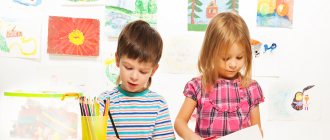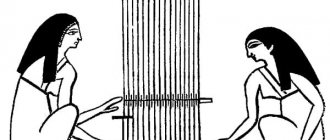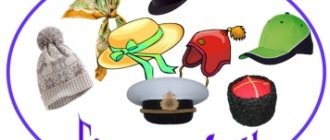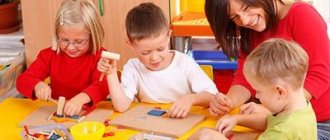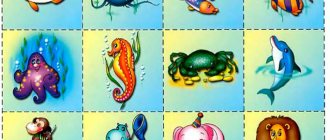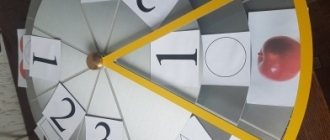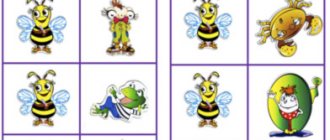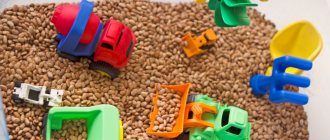Fourth wheel
Target. Development of thinking.
Task. Familiarization with the surroundings (clothes, shoes, hats).
Equipment. Subject pictures with images of clothes, shoes, hats.
Progress of the game
The teacher will put pictures on the typesetting canvas with images of three items of clothing and one pair of shoes or three pairs of shoes and one headdress and invites them to examine and name them. You can invite children to remember poems, nursery rhymes, and riddles about these objects. Then the children are given the task of determining which picture is odd and why.
You can play the game in a similar way by placing on a typesetting canvas three pictures with images of multi-colored clothes and one with images of plain clothes, or three pictures with images of clothes for winter and one picture with images of clothes for summer, etc.
What's missing? Target. Development of visual attention and perception. Task. Familiarization with the surroundings (clothes, shoes, hats).
Equipment. Subject pictures with images of clothes, shoes, hats.
Progress of the game
The teacher will place pictures on the typesetting canvas with images of four to five items of clothing, shoes, and hats, asking them to examine and name them. You can invite children to remember poems, nursery rhymes, and riddles about these objects. Then the children are asked to close their eyes. At this time, the teacher removes one of the pictures. Having opened their eyes, children must determine what is missing.
What changed? Target. Development of visual attention and perception. Task. Familiarization with the surroundings (clothes, shoes, hats).
Equipment. Subject pictures with images of clothes, shoes, hats.
Progress of the game
The teacher will put pictures with images of clothes, shoes, and hats on the typesetting canvas, asking them to look at and name them. You can invite children to remember poems, nursery rhymes, and riddles about these objects. Then the children are asked to close their eyes. At this time, the teacher swaps two pictures or puts another instead of one picture (thin socks instead of woolen socks). Having opened their eyes, children must determine what has changed or which pictures have swapped places.
What appeared? Target. Development of visual attention and perception. Task. Getting to know those around you! (clothes, shoes, hats).
Equipment. Subject pictures with images of clothes, shoes, hats.
Progress of the game
The teacher places pictures with images of four to five items of clothing, shoes, and hats on the typesetting canvas, asking them to examine and name them. You can invite children to remember poems, nursery rhymes, and riddles about these objects. Then the children are asked to close their eyes. At this time, the teacher places another picture on the typesetting canvas. Having opened their eyes, children must determine what object has appeared.
Choose a scheme
Target. Development of sound word analysis skills.
Task. Familiarization with the surroundings (clothes, shoes, hats).
Equipment. Subject pictures with images of a hat, fur coat, jacket, raincoat. Cards with sound patterns of these words.
Progress of the game
The teacher places pictures with images of a hat, fur coat, jacket, and cap on the typesetting canvas. Children look at the pictures and name them. Then the teacher invites the children to take one card with a sound diagram of the word from a bag, chest or container. Children complete the task and then look at the diagrams. Next, they are given the task of putting diagrams under those pictures whose names correspond to the diagrams in terms of sound composition.
Syllabic domino Goal. Improving the skill of syllabic analysis of words.
Equipment. Subject pictures with images of clothes, shoes, hats (scarf, raincoat, fur coat, hat, trousers, dress, leggings, sneakers, mittens, overalls). Cards with images of one, two, three and four squares.
Progress of the game
The teacher will place pictures of clothes, shoes, and hats on the typesetting canvas. Children look at and name them. The teacher puts cards with images of one, two, three and four squares in a row. He explains that the squares represent the number of syllables in the names of objects. Next, children are given the task of arranging pictures with images of clothes, shoes and hats into a square, depending on how many syllables their names are divided into.
Lesson on speech development in kindergarten. Senior group. Topic: Clothes
Summary of a lesson on the development of children's speech in the senior group on the topic: “Clothing”
Program objectives Educational: Continue to teach how to describe items of winter clothing Continue to teach to correctly answer the teacher’s questions with a complete answer Developmental: Clarify and systematize children’s ability to distribute clothes according to the seasons (Winter, summer) Educational: To develop a caring attitude towards clothing. Vocabulary work: Ancient man, winter, spring, summer, autumn, clothes, parcel, fur coat, hat, boots, scarf, mittens Materials and equipment: Envelope with the image of an ancient man, parcel, pictures depicting clothes at different times of the year, Preliminary work: Educator: writing notes, preparing material and equipment Children: Conversation on the topic of clothing, looking at illustrations depicting clothes, solving riddles “Clothing” Methodology Stages Contents Note Introductory part Educator : Guys today, when I went to kindergarten, I found K an envelope , do you want to know what's there? Let's quickly open it and see what's there. Educator : Look who is depicted in the picture? Children: An ancient man Educator : That's right, guys, this is an ancient man. He asks us to help him and tell him how to dress in the cold season. Children are sitting at tables
. I show the envelope, open it with the children, and pay attention to the image of an ancient man.
Main part. Educator: - B In ancient times, people lived in caves and made clothes from animal skins. - What do you think, if you and I were wearing such clothes now, what would happen to us? Children: Frozen / Educator: - Why would we freeze? Children: Because it’s cold outside now. Educator: That's right, guys. Late autumn has arrived. — If you met a person dressed in clothes made from animal skins, what would you advise him to wear in order not to freeze? Children: Jacket, boots, hat, mittens, scarf Educator: - Now guess what I suggest our primitive man wear. I’ll tell you riddles, and you guess Five fingers, like people’s, but her fingers have no nails. (glove) I walked along the road, I found two roads, I followed both. (Pants) House for the head. (Hat) It’s black, not earth, fluffy, not snow, warms, not a stove. Fur coat Educator: Well done guys, you guessed everything correctly, do you think a person will become warmer if he puts on these clothes? Children: yes. Educator: Now let's get up from the tables and rest a little. Winter has come. It's getting cold. (we spread our arms to the sides, cross them on our chests) Oh, yes. Oh, yes, yes. We are not afraid of the cold. (We clap the rhythm with our hands) So that our feet do not freeze, We put on boots (we alternately place our feet forward on the heel) Oh, yes. Oh, yes, yes. We are not afraid of the cold. (we stamp the rhythm with our feet) Hat, help us out, warm our ears. (rubbing our hands over our ears) Oh, yes. Oh, yes, yes. We are not afraid of the cold. (clap the rhythm with our hands) To warm our hands, we need to put on mittens. (imitates putting on mittens) Oh, yes. Oh, yes, yes. We are not afraid of the cold. (clap the rhythm with our hands) We’ll put on a new jacket and warm pants. (imitation of putting on a jacket and pants) Educator: Guys, what is the name of the clothes that we put on in winter? You need to answer in full Children: In winter we put on winter clothes Educator: That's right, but in the spring? Children: In the spring we put on spring clothes Educator: Well done, guys, and when summer comes, what clothes will we wear? Children: In the summer we wear summer clothes Educator : And in the fall? Children: In the fall we put on autumn clothes. Teacher : so we had a rest, and now let's play an interesting game. Did. Game “winter, summer” Purpose: To develop in children the skills of distributing clothes by season Educator: And now I suggest you divide clothes into winter and summer. Now everyone will come up to me and take a picture with a picture of clothes, you will need to attribute it to the right time of year.. Where winter clothes are shown we will put them in a parcel for an ancient person, and where summer clothes are shown we will put them aside Educator : Well done guys, they all coped well with the task Conversation on the topic “Clothing”. Educator: Please look at the board. What do you see on it? Children: Winter clothes Teacher: That's right, I will show you a picture of clothes and ask a question For example: “What kind of coat is this? (winter, warm). And you must answer with a complete answer. Everyone understood the task. Children: yes. Teacher: then let’s start completing it. What kind of jacket? (fur). What colour? What does the coat have? What does the jacket have? (collar, sleeves, pockets, buttons). What is a scarf for? (so that it is warm, so that it does not blow, so that the cold does not creep up your neck). About what we say “fluffy”, “fur”, “soft” I begin my story. I achieve logical thinking in children. I listen to the children's expected answers. each child who guessed goes to the table, finds the clothes they guessed, puts the shoes in a box (parcel) I praise the children I give a physical education lesson
Children imitate movements during the poem I ask children questions I encourage them to answer correctly with a complete answer I conduct a didactic game “Winter, Summer” Illustrations of winter clothes are on the board . I draw attention to the fact that children name color, individual qualities, and purpose. I ask several children. Final part. Teacher, well done guys, everyone turned out to have very good stories, he now knows how to dress correctly in the winter season. Guys, let's remember what we talked about today? Children: about clothes Teacher: what clothes do you know? Children: Jacket, fur coat, hat, boots, mittens, scarf Educator: Correct, what is the name of the clothes we wear in winter? Children: Winter clothes Educator: What about the clothes we wear in the summer? Children: Summer clothes Educator: Guys, for helping the Ancient Man, he sent you each a medal. I praise the children, We remove everything, I give medals to the children.
Download Summary of a lesson on speech development for children in the senior group on the topic: “Clothing”
We recommend watching:
Notes for a lesson on speech development in the senior group: Special purpose transport Notes for a lesson on speech development for children in the senior group of preschool educational institutions Notes for the development of speech in the senior group “Wild Animals of Russia” Notes for a lesson on speech development in the senior group. Nosov "Gardeners"
Similar articles:
Summary of a lesson on speech development in the senior group. Compiling a descriptive story based on a painting
Summary of a lesson on speech development in the senior group. Reading works of fiction
Summary of a lesson on speech development in the senior group. Retelling of a work of art. Charushin "Sparrow"
Summary of a lesson on ecology in the senior group of kindergarten on the topic “Man and Nature”
Lesson on emotional development in the senior group
Thematic selection of games and exercises, topic: “Shoes”
Goals:
Expand children's knowledge and enrich their vocabulary on this topic. Introduce children to the concept of “pair”, the general concept of “shoes”. Form stable ideas about color, size, geometric shapes. Improve skills in painting, gluing, and sculpting. Continue to teach children to listen carefully to the poem and understand the meaning of what they hear. Develop thinking, fine motor skills, coordination of movements. Cultivate a caring attitude towards shoes.
Equipment:
Chest, doll, doll shoes. Cartons cut out of cardboard in red, green, yellow and blue and shoes in the same colors. Cardboard silhouettes of boots with pasted circles of different colors and sizes, buttons of the corresponding color and size. Silhouette images of shoes made of thick cardboard with holes, multi-colored laces. Picture and image of three bears of different sizes, ovals-shoes of the corresponding size. Pictures depicting various shoes and mittens. Multi-colored clothespins, silhouettes of brushes without bristles made of thick cardboard. Silhouettes of boots cut out of oilcloth, smeared with crayons, wet sponges. Cardboard silhouettes of boots with cut out holes in the form of geometric shapes, the same shapes. Background picture with shadows of various shoes, color silhouette pictures of these shoes. Paper clips, color silhouette images of shoes. Picture “Centipede”, plasticine set. Coloring book “Boot”, brushes, paints. Boots and pictures cut out of colored paper (flowers, fish, clouds, suns, Christmas trees). Audio recordings: “Centipede”, “Big feet are walking along the road”.
